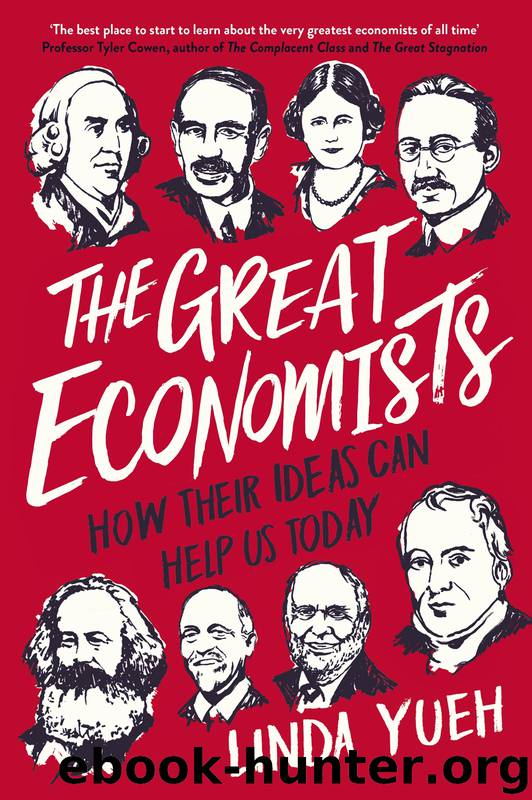The Great Economists by Linda Yueh

Author:Linda Yueh
Language: eng
Format: epub
ISBN: 9780241974483
Publisher: Penguin Books Ltd
Published: 2018-01-03T05:00:00+00:00
China’s innovation challenge
China is the major economy currently facing the considerable challenge of becoming an innovator. Is it possible for ‘Made in China’ to become ‘Designed in China’? Japan made that transformation, but many more countries have failed than have succeeded.
In the 1980s movie Back to the Future, Michael J. Fox’s character Marty McFly travelled back in time to the 1950s. He met a scientist who demanded proof that he was from the future. Even though Doc Brown scoffed at the idea of an actor (Ronald Reagan) as the US president, Marty managed to convince him. But Doc’s incredulity was further stretched when Marty says that in the future Japan will make ‘all the best stuff’. In Doc’s time, ‘Made in Japan’ was synonymous with products that were cheap and of low quality.
In roughly thirty years, Japan came to rival the United States and was the world’s second-largest economy. Japanese manufacturing was transformed from producing low-cost goods into launching world-beating companies such as Toyota. Now that China has overtaken Japan economically, could its companies become the next global competitors? Just as one company can overtake another, so one country can overtake another too.
Innovation, of course, takes many forms. But there’s one thing in common: talent. It’s what Joseph Schumpeter pointed out, which is that innovation comes from innovators. Can China produce the next Steve Jobs, for instance? Will there be innovators that transform the way that we live through their inventions and ingenuity? The answer to the question of Chinese innovativeness goes beyond manufacturing and into all areas of society, including the creative industries.
The Chinese government is actively investing in innovation. R&D spending has increased rapidly. China is predicted to surpass even US R&D spending in the coming years. Of course, it’s not just what is spent or the number of patents filed that determines innovation. It’s how useful these inventions are. And that data does not yet exist for China.
To complicate matters, much manufacturing now involves global supply chains. For instance, half of China’s exports are made by foreign-invested enterprises, so it’s multinational companies that are producing in China as well as domestic firms. Harvard economist Dani Rodrik estimated that the value of Chinese exports suggests that they come from a country with a much higher per capita income. Does that mean that China produces innovative exports or is it a place for global assembly?
A case study is Huawei. The giant telecoms equipment firm was founded in Shenzhen in 1987 by Ren Zhengfei. It imported telecoms equipment from nearby Hong Kong, just across the then Chinese border. It now makes the networks that power the internet and mobile phone networks around the world. Huawei products are used by companies such as Vodafone since they make the USB dongles that provide mobile internet connections. As mentioned above, it has also entered the smartphone market. Ren could be one of Schumpeter’s entrepreneurs since he transformed his business from being just an importer of telecoms equipment into the world’s largest telecommunications company, one that invests heavily in R&D and technological innovation.
Download
This site does not store any files on its server. We only index and link to content provided by other sites. Please contact the content providers to delete copyright contents if any and email us, we'll remove relevant links or contents immediately.
International Integration of the Brazilian Economy by Elias C. Grivoyannis(57292)
The Radium Girls by Kate Moore(10903)
Turbulence by E. J. Noyes(7033)
Nudge - Improving Decisions about Health, Wealth, and Happiness by Thaler Sunstein(6629)
The Black Swan by Nassim Nicholas Taleb(6184)
Pioneering Portfolio Management by David F. Swensen(5600)
Rich Dad Poor Dad by Robert T. Kiyosaki(5140)
Zero to One by Peter Thiel(4818)
Man-made Catastrophes and Risk Information Concealment by Dmitry Chernov & Didier Sornette(4731)
Secrecy World by Jake Bernstein(3774)
Millionaire: The Philanderer, Gambler, and Duelist Who Invented Modern Finance by Janet Gleeson(3566)
Skin in the Game by Nassim Nicholas Taleb(3456)
The Age of Surveillance Capitalism by Shoshana Zuboff(3413)
The Money Culture by Michael Lewis(3277)
Skin in the Game: Hidden Asymmetries in Daily Life by Nassim Nicholas Taleb(3259)
Bullshit Jobs by David Graeber(3173)
The Dhandho Investor by Mohnish Pabrai(3162)
The Wisdom of Finance by Mihir Desai(3070)
Blockchain Basics by Daniel Drescher(2884)
